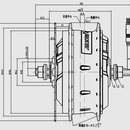Introduction: Fleishman Furniture
I've been fascinated by Gregg Fleishman's CNC chairs for years: such a clever idea, to carve from a single sheet of plywood a fully functional chair, with effective cushioning and back support, not to mention tremendous style. Having gotten some ShopBot training, and in search of a project to make use of that training, I chose Fleishman's Lumberest chair as a good intro to that machine and to subtractive manufacturing in general.
As usual, I completely misjudged the difficulty of this project but, as sometimes happens, I was bailed out by a more experienced Maker (and Instructables fan), filthyPhil, with happy results. This Instructable tells you what we wish we'd known before setting out to make one of Fleishman's designs.
Step 1: Selecting and Obtaining a Design
As a quick visit to Fleishman's website (which is where I got the picture, above) will show, there are a lot of different designs to choose from. We've only made one of them, but we've sat in three of the dozen some-odd chairs currently (early 2016) shown there and note that all of them are springy. This means that if you're looking for a dining chair or a work chair then chances are none of these will suit your purposes well. Also, while in all available designs two pieces of plywood will have to be inserted into one another at one or more points, in some designs that insertion will be simpler than in others. In general, the more points of insertion and the more precise the fit required at those points, the more difficult it will be to assemble the chair and the more likely you are to face issues related to tight tolerances. Finally, note that designs with cuts on the back of the chair parallel to the floor may tend to catch your belt as you get up; certainly the one I chose does.
Having selected a design you'll have to contact Gregg (via his website) to get it. A few notes from my experience transacting with him:
- Gregg charged me $200 for the design, which gave me the right to make two chairs only.
- The design file Gregg supplied was a .dwg with dozens of irrelevant layers and no instructions either in the file or in the email accompanying it.
- Gregg was reasonably responsive to my emails, but I wouldn't count on him to answer a question overnight or even within a few days.
So don't expect Gregg to deliver a detailed set of instructions or handhold you through the process. That's what Phil was for!
Step 2: Working With the Design File
The first thing I did with the file was to open it up into Adobe Illustrator, this is my vector drawing app of choice but you could also use Inkscape, AutoCAD or any other vector software that can import DWG files. Once I had the file open I got rid of any of the vectors that I didn't want to cut (such as text labels and bounding boxes).
I made my artboard 48"x48" as I knew the plan was to cut this out of a 1/2 sheet of plywood. Then I positioned the two parts on the art artboard to make sure they would fit…. It was tight but they did fit.
As this was not my design I needed to see what size router I needed to make the cuts, there were some pretty tight slots and using the measuring tool in Illustrator I measured the narrowest one. It looked like a 1/8" router bit would be a good size.
The next task was to make the tool paths. I use vCarve Pro for creating my paths, it's pretty easy to use and it's also what is installed on the ShopBot at TechShop so if i need to make any changes my files will open no problem. (This isn't an Instructable about how to use vCarve as there are plenty of tutorials out there.) I created 4 profile tool paths in total, 2 for the smaller piece and 3 for the larger piece. The reason I did 2 was that I wanted the outside cut to cut on the outside of the vector and the inside piece to cut on the inside of the vector.
When I first previewed the profile cuts the preview looked incorrect, it seems like some of the slots in the file are slightly less than 1/8" so vCarve wouldn't send a 1/8" bit up there. A simple hack to solve this issue was to tell vCarve that the bit was only 0.120" in diameter. This was only a tiny difference (1/8" is 0.125") but it totally worked.
My usual rule of thumb for setting the pass depth is to route a depth of 1/2 of the diameter of the bit. Cutting 3/4" with an 1/8" bit would mean 12 passes. I knew this was overkill so I decided to try doing my passes at 1/8" and it worked great.
Step 3: Materials
Our chair was a prototype: we made it to find out how well our toolpaths worked and to see what the final product actually felt like. And since we were prototyping we didn't worry too much about getting exactly the plywood we'd want for the final product. The chairs shown on Fleishman's site are made from a particularly expensive and difficult-to-source piece of ply, namely phenolic plywood or, as Gregg called it (and some sites do), EuroColorPly. This plywood will give you a final product that is pre-finished in the color of your choice. It is also a high-ply-count plywood, which is to say it has lots of layers and is thus somewhat stronger than a cheaper, more grossly layered product. Again, we didn't use that (yet), but did use the highest 3/4 inch ply sheet we could find with both sides pre-finished.
Whatever plywood you select, if you are working with a half sheet (and a half sheet is all that's needed for one copy each of the two pieces you need to make a single chair) make sure it is halved precisely: you'll be getting dangerously close to the edges no matter how you lay out the two pieces you need to cut.
Because we were using a pre-finished product we were careful to select a bit that would leave clean edges: our goal was to have to do little if any post-processing (sanding) once we've pulled the pieces from the ShopBot. We used 1/8" (3.175x32mm) carbide 2-flute spiral CNC router bits (we found these bits on eBay: delivery was slow but they are very cheap and performed admirably); you'll want several spares.
Other than that, you'll need some nylon nails to secure the material to the ShopBot's worktable, fine grained sandpaper (ideally you'll use a rotary sander for what little finishing there is), and you may want to think about a dust mask and hearing protection: you'll be spending a long time next to that ShopBot and might as well be comfortable.
Step 4: Routing
Our goal in this Instructable is not to teach you how to use a ShopBot, there's lots better material out there for that. We're focusing here just on what was helpful to know about this project in particular. Here are our tips:
- We advise cutting the chair's seat (the smaller cut, shown above) first. These toolpaths are the shortest in the design, so experimenting with finding the right number of cuts to make to get you through the full 3/4 inch sheet is best done here. You'll want to see how fast you can do the cuts, too, and if you make a fatal mistake along the way you can always start over on the other available quarter space on your half sheet of ply, whereas if you make a mistake when cutting the bigger part you may be forced to start over on a fresh sheet.
- If you're working with a half sheet, the exterior perimeter on the main part of the chair will take you awfully close to the edge of your plywood, so close you may not have enough room to secure the sheet directly. We recommend pressing some scrap up against that edge and then nailing that down firmly; the pressure should keep the production sheet in place.
- We used tabs to keep the inner parts secure.
- The total time on the ShopBot was @3 hours; we made this chair at TechShop (thanks guys!) and were able to reserve a four hour block of time to do so.
Step 5: The Chair in Use
You're going to do two things with this chair: set it up/break it down and sit in it. There are problems with both. First, because the original design doesn't have a chamfer or other softening element on any edge it's all too easy to take off a ply or two when moving the chair around or guiding the seat piece into the back or the two arm flanges into their cut-outs. A tougher finish, as on the Euro-ply, may reduce this, but I think the right solution is to add a chamfer on all exterior edges. Doing so will require adding another tool path for that cut and sourcing an appropriate bit. We did not have any problems with tolerances (the chair fit together fine right off the ShopBot) but have heard that other models can be tricky that way.
And then there's the sitting. The chair fits some people much better than others, and the horizontal slats in the back tend to catch the waist of your pants, belts, and other parallel-to-the-floor elements of attire. Even if it fits you well, the chair isn't comfortable enough for lounging but is also too reclined for working in. Finally, it creaks a good deal, especially with a heavier load, and while it's held upwards of 170 lbs., the heavier you are the more likely you are to worry the thing is going to give way underneath you...not a relaxing experience. It's possible a higher ply number may make the chair seem stronger, and indeed may actually do so. Yes, possible.
In sum, while this has been a very interesting and enjoyable project, the chair itself is more art than functional furniture. I've accomplished my mission of learning something about ShopBots and associated software but have had to admit to my wife I'm no closer to building that set of dining chairs I've promised her.
Thanks again to TechShop (and to my employer, Autodesk, for providing ShopBot training and giving me a membership to TechShop) and to filthyPhil for seeing this through!












